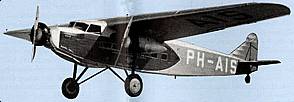

from KLM to DCA

Royal Dutch Airlines

West Indian Division
After KLM Royal Dutch Airlines had opened the Oost-Indië Route to Indonesia, they naturally cast a beady eye on the Dutch colonies in the West, with their Fokker aircraft the best in the world. A strong impetus was the enormous hidden subsidy the Nederlandsche Posterijen paid in the form of premium freight rates for mail. This lucrative tradition was continued from the days of steam and amounted to a yearly contribution of 1.5M Dutch 1930 guilders on the East-India route.
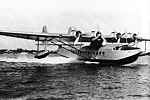
P.A.A. Sikorsky S-42
The 1919 SCADTA, later incorporated in Avianca of Colombia (which is, after that manner, the oldest still flying airline in the world) in 1926 unsuccessfully tried to open a route Barranquilla-Curaçao with flying boats.
In 1928 Pan American World Airways started mail flights from Miami to Paramaribo (capital of the Dutch colony Suriname) and, from 1930, on to Buenos Aires. They used seaplanes until 1941. The two routes in 1928 were Miami-Kingston/Jamaica-Barranquilla/Colombia, and Miami-Trinidad-Paramaribo. Barranquilla and Trinidad were connected via Maracaïbo/Venezuela-Curaçao-Puerto Cabello/Venezuela. P.A.A. used Sikorsky S-38 amphibians, one of which was flown in by Charles Lindberg as a goodwill ambassador. After a runway was completed these landed on Hato airport. When P.A.A. acquired more landing rights in Venezuela, they stopped flights on Curaçao.
An extinct French company opened a South-Atlantic crossing in 1928, to start Aeropostal in Venezuela. With the bankruptcy of the French mother company, the Venezuelan government took over and the company finally emerged as LAV Linea Aeropostal Venezolana.
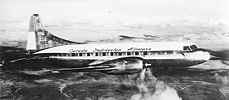
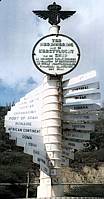
Hato Airport Monument
Lines were opened to Maracaïbo, 1936 and Caracas/Venezuela, 1937, Bonaire island and Barranquilla, 1938; Paramaribo/Suriname, Port of Spain/Trinidad, and Barcelona/Venezuela in 1939. Apart from the FXVIII Snip and Oehoe (later renamed Oriol), the FVIII Duif was in service from 1937 to 1939, when it was sold to Venezuela. In 1939 Douglas delivered two DC5 aircraft, which in 1941 were sold to the East India Division Koninklijke Nederlandsch-Indische Luchtvaart Maatschappij. Curaçao-Aruba-Kingston/Jamaica followed in 1941. Curaçao-Havana/Cuba-Miami, 1942 (later Curaçao-Camaguey-Miami).The first Lockheed L-18s Super Electra joined the fleet with the L-18 Lodestar.
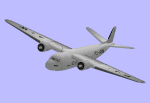
DC5 Wakago
| 1939 | 1940 | 1941 | 1942 | 1943 | 1944 | |
| Total routes (km) | 4181 | 4147 | 4355 | 5004 | 7265 | 9510 |
| Flight hours | 3398 | 4058 | 4179 | 5996 | 7474 | 8026 |
| Passengers | 14578 | 17593 | 20513 | 25817 | 33152 | 33741 |
| Passenger kms. | 3,692,460 | 4,249,357 | 5,631,824 | 11,314,293 | 17,211,051 | 17,366,063 |
| Freight & excess luggage, kgs. | 117,356 | 158,554 | 198,101 | 247,335 | 329,392 | 352,245 |
| Kgs. of mail | 10,632 | 11,980 | 13,854 | 25,591 | 55,210 | 34,184 |
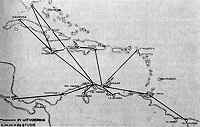
compare with ALM route map
| kms. | flight routes 1946 | from/to Curaçao | ||||
| 117 | Aruba | |||||
| 1739 | Port of Spain | Paramaribo | ||||
| 79 | Bonaire | |||||
| 907 | Aruba | St. Maarten | ||||
| 784 | Ciudad Trujillo | Aruba | ||||
| 282 | La Guaira | |||||
| 2093 | Aruba | Port au Prince | Camaguey | Miami | ||
| 2024 | Aruba | Kingston | Miami | |||
| 663 | Aruba | Barranquilla | ||||
| 388 | Aruba | Maracaïbo | ||||
| 408 | La Guaira |
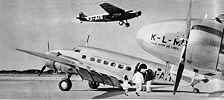
Snip, Troepiaal and Parkiet
In 1947 KLM's West-Indisch Bedrijf offered these services from Curaçao:
| 1/day | Aruba | Kingston | Miami | ||
| 2/week | Ciudad Trujillo | Port au Prince | Kingston | Havanna | |
| 2/day | Caracas | ||||
| 3/week | Port of Spain | Paramaribo | |||
| 2/week | Port of Spain | ||||
| 2/week | Aruba | Barranquilla | San José | ||
| work days | Bonaire | Port au Prince | |||
| weekly | St. Maarten | St. Kitts | |||
| 1/day | Aruba | Maracaïbo | |||
| 3/day | Aruba |
This phenomenal growth had much to do with Venzuelan oil, refined in Curaçao and Aruba. The WWII Allies were totally dependent on Curaçao's Isla for all aircraft fuel used in the United Kingdom. With the Esso Lago refinery in Aruba, business boomed and kept KLM alive and well. Company headquarters were transferred to Curaçao, with as only other operation the DC3 flights London-Lisboa.
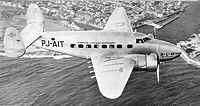
Electra over Willemstad harbor
The US government was giving away Lockheed L14 Electras all over the place, mainly to combat German influence in South America. Ernest K. Gann has some rattling good stories to tell about delivery of these. The L14 was much less old-fashioned to our eyes than the Fokkers were. Comparing them, the Fokker is like an old-fashioned automobile, while the car industry only adapted the techniques used in the L14 after W.W.II. KLM used several L14s and L18s.
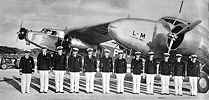
Fokker, Lockheed and crews
| Aircraft | end 1946 | |||
| Lockheed | L14 | Super Electra | PJ-AIK | Kolibri |
| PJ-AIM | Meeuw | |||
| PJ-AIT | Troepiaal | |||
| Lockheed | L18 | Lodestar | PJ-AKA | |
| PJ-AKB | ||||
| Douglas | DC3 | PJ-ALA | Ala Blanca | |
| PJ-ALB | Blauwduif | |||
| PJ-ALC | Chuchubi | |||
| PJ-ALD | Dekla | |||
| Douglas | C47E | military DC3 | PJ-ALE | |
| PJ-ALG | (photography) | |||
| PJ-ALH | (in conversion) | |||
| Douglas | C54A | military DC4 | PJ-ALK | Kralendijk |
| PJ-ALO | Oranjestad | |||
| PJ-ALW | Willemstad | |||
| Fokker | FXVIII | PJ-AIS | Snip |
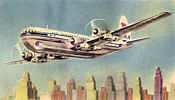
After the war Pan American flew to Curaçao with Boeing Stratocruisers.
The KLM-WIB fleet consisted of Douglas DC4s, used between the Antilles and Caracas/Miami; other routes were flown by DC3s.
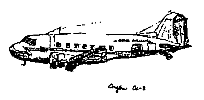
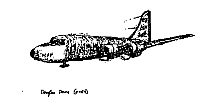
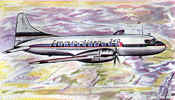
DC3 and DC4 by Ernest K. Gann; Convair 340 Metropolitan
In 1954 four Convair 340s were added, joined in 1957 by DC6s.
The Convairs then moved on to the shorter routes and the DC3s were phased out.
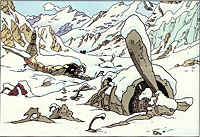
Chuchubi in Nepal?
The last one, Chuchubi, was sold to Royal Nepal Airlines in 1961.
The Snip was junked in the mondi (bush) by Hato Airport.
Douglas DC6
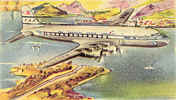
(But where's the bridge?)
KLM West-Indisch Bedrijf was taken over in 1964
by ALM Antilliaanse Luchtvaart Maatschappij (Antillean Airlines)



copyright notice
all material on this site, except where noted
copyright © by , curaçao
reproduction in any form for any purpose is prohibited
without prior consent in writing
